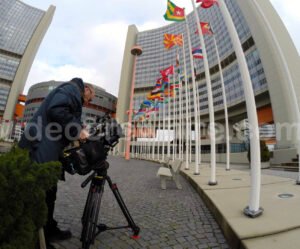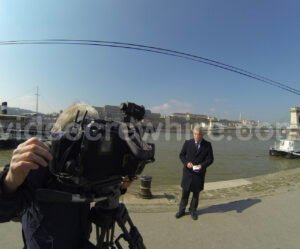Technical Challenges of Using Zoom vs. LiveU

Remote video production using Zoom for a US client in Bratislava, Slovakia.
Remote video production has become increasingly prevalent in various industries, from film and television to live event broadcasting. While Zoom has emerged as a popular, accessible solution for remote meetings and casual streaming, professional-grade solutions like LiveU are often deemed superior for high-stakes remote video productions due to their specialized technology and reliability. We look into the technical challenges of relying on Zoom for remote video productions compared to employing LiveU solutions.
Video and Audio Quality
Zoom is designed with general users in mind and prioritizes efficiency over broadcast quality. Its adaptive streaming technology, which adjusts video resolution based on available bandwidth, can result in subpar video quality during low-bandwidth situations. This loss of clarity may be acceptable for virtual meetings but falls short for remote video productions, where delivering consistently high-definition (HD) or 4K quality is crucial.
LiveU, created for professional broadcasting, provides superior video quality using advanced encoding methods and high-efficiency video coding, especially in location where internet connectivity is poor. Its solutions deliver low-latency, high-definition video streams, essential for productions where every detail counts, such as in live injects on big screens, live sports or remote newsgathering.

Live transmission for the Kansas City Chiefs using LiveU 300S devices from Munich, Germany.
Reliability and Connectivity
Zoom sessions can experience lags, dropped connections, and buffering issues, particularly in scenarios where internet bandwidth is inconsistent or during broadcasts involving multiple participants. For remote video productions, such disruptions can hinder the delivery of uninterrupted content.
LiveU utilizes patented cellular bonding technology, which amalgamates multiple network connections (cellular, WiFi, and satellite) to create a robust and reliable internet connection. This multi-channel approach ensures seamless and stable video transmission, even in remote or bandwidth-challenged locations.
Integration with Professional Equipment
Zoom is primarily an online software service and does not natively support integration with complex broadcast equipment, such as professional cameras, switchers, and encoders. While workarounds exist to include Zoom in professional setups, these often require additional hardware and software, raising the potential for technical difficulties.
In contrast, LiveU solutions are designed with compatibility in mind, allowing straightforward integration into professional broadcasting environments. This compatibility streamlines the workflow from video capture to content distribution, enhancing efficiency and reducing the risk of equipment or software-related disruptions during live productions.

Celebrating Porsche’s 75th anniversary with a live injects from Zagreb, Croatia using LiveU 300S unit.
Latency and Synchronization
In remote video productions, the precision of video and audio synchronization is paramount. Even slight delays can disrupt viewer experience and the professional image of the production. Zoom, despite optimizations, is prone to latency issues which can affect the timing between audio and video streams.
LiveU’s low-delay protocols ensure minimal transmission latency, facilitating real-time synchronization that is vital in live broadcasts and fast-paced production environments. This ensures that content, whether interviews, on-the-ground reporting or live events, reaches the audience in sync.
Security Considerations
Security is a critical aspect of video production, especially for sensitive content. Although Zoom has improved its security features over time, its early security lapses have positioned it as potentially less secure for high-profile productions.
LiveU boasts robust security measures, including encryption and secure data transmission, providing an additional layer of confidence for broadcasters managing confidential content. This security is crucial for producing live remote video content that respects privacy and intellectual property.

Live production from Prague with green screen using Zoom.
Cost and Scalability
While Zoom is cost-effective for personal and small-to-medium group meetings, its limitations in professional video production may not justify the savings in critical use cases. Technical issues arising from its casual-use design could lead to additional unforeseen costs.
LiveU’s professional solutions, though potentially more expensive up front, offer scalability and features that ensure quality and dependability, minimizing the risk of costly production errors. Investing in LiveU can thus be a cost-effective decision for high-stakes productions where failure is not an option.
Choosing between Zoom and LiveU solutions for remote video production depends on the specific needs and constraints of the project. Zoom can suffice for simpler, budget-conscious applications. However, for productions requiring flawless, high-quality video transmission and reliability, LiveU’s purpose-built technology stands out as the robust, professional choice. Understanding these differences allows producers to mitigate risks, deliver superior content, and maintain the high standards expected in today’s competitive media landscape.


